Cyrus the Great › Artaxiad Dynasty › Colchis & Iberia in Antiquity » Origins and History
Articles and Definitions › Contents
- Cyrus the Great › Who Was
- Artaxiad Dynasty › Origins
- Colchis & Iberia in Antiquity › Origins
Ancient civilizations › Historical places, and their characters
Cyrus the Great › Who Was
Definition and Origins

Cyrus II (d. 530 BCE), also known as Cyrus the Great, was the fourth king of Anshan and the first king of the Achaemenid Empire. Cyrus led several military campaigns against the most powerful kingdoms of the time, including Media, Lydia, and Babylonia. Through these campaigns, he united much of the Middle East under Persian hegemony while keeping the local administration mostly intact. By guaranteeing some continuity and thus winning the loyalty of the elite, he laid the foundations for the Achaemenid Empire.
EARLY LIFE
Not much is known about the early life of Cyrus. The various oral traditions relating to his birth and youth are preserved only in the works of Greek authors like Herodotus, Ctesias, and Xenophon, who present contradictory accounts of a mostly legendary nature. According to the most well-known account of Herodotus, Cyrus was the son of the Persian king Cambyses (c. 580-559 BCE) and the Median princess Mandane, daughter of the Median king Astyages (585-550 BCE). Ctesias explicitly contradicts Herodotus, however, claiming instead that Cyrus was the son of a Persian brigand named Artadates and his wife, the goatherd Argoste. According to Ctesias, Cyrus served at Astyages' court as a chief cupbearer before overthrowing him.After his coup, Cyrus adopted Astyages as his father and married his daughter Amytis.
According to contemporary Achaemenid inscriptions, like the Cyrus Cylinder and the Behistun Inscription, Cyrus was king of Anshan (a kingdom in Fars with a mixed Elamite and Persian population) and a son of Cambyses. However, it must be noted that the Achaemenids inscriptions never mention any genetic relation between Cyrus and Astyages. Although intermarriage between Iranian royal families is certainly a possibility, it is also possible that Cyrus only claimed to be Astyages' grandson in order to gain legitimacy (as per Herodotus) and that he married Astyages' daughter Amytis for the same reason (as per Ctesias). Finally, Herodotus, Ctesias, and Xenophon all agree that Cyrus spent part of his youth at Astyages' court. This may be based on historical truth, but, again, this may also simply be a legendary motif.

Childhood of King Cyrus
CONQUEST OF ECBATANA
Cyrus' first great achievement was his conquest of Ecbatana, the Median capital ruled by Astyages. This event is first mentioned in two contemporary Babylonian sources: the Nabonidus Cylinder of Sippar and the Nabonidus Chronicle.Herodotus also gives us a detailed account of this event. According to the Nabonidus Cylinder of Sippar, Cyrus, king of Anshan, rose up against his overlord, the Median king Astyages, in 553 BCE. After defeating the "vast Median hordes" with his "small army", he captured Astyages and brought him back to his homeland. The Nabonidus Chronicle states instead that Astyages marched on Cyrus in 550 BCE, but his army rebelled against him, took him captive and handed him over to Cyrus.Cyrus then took Ecbatana and carried off the spoils. The discrepancy in dates between these two sources may be explained by assuming that Cyrus started his rebellion in 553 BCE, that Astyages marched against Cyrus in 550 BCE and that the revolt in the Median army happened during that campaign.
CYRUS SPARED ASTYAGES' LIFE & ACCORDING TO CTESIAS, HE EVEN MARRIED ASTYAGES' DAUGHTER AMYTIS, PRESENTING HIMSELF AS THE RIGHTFUL SUCCESSOR OF ASTYAGES AS KING OF THE MEDES.
Herodotus' account agrees with the Nabonidus Chronicle up to a great degree. Herodotus states that Harpagus, a Median nobleman, encouraged Cyrus to rise up against Astyages, who had wronged him in the past. Harpagus sought support from among the other Median nobles, who were also unhappy with Astyages' rule. Astyages, upon hearing about Cyrus' rebellion, appointed the same Harpagus to lead the Median army against Cyrus. When the Median and Persian armies met, Harpagus and the other noblemen crossed over to Cyrus as planned. All sources agree that Cyrus spared Astyages' life. If we are to believe Ctesias, Cyrus even adopted Astyages as his father and married his daughter Amytis, presenting himself as the rightful successor of Astyages as king of the Medes. It is often assumed that Cyrus took over all the lands that had been conquered by the Medes, which according to Herodotus encompassed all of Asia except for Assyria, however, recent research concludes that the territory of the Medes was much smaller or even that there was no Median Empire at all. Still, it seems likely that Cyrus' power and prestige on the Iranian Plateau increased greatly after this victory.
BUILDING OF PASARGADAE
After his victory over Astyages, Cyrus founded the city of Pasargadae on the site of the battle. Pasargadae served as a ceremonial capital of the early Achaemenid Empire and was never meant to house a large population. The city consists of several monumental buildings spread out across the Murghab plain, most notably the Tall-e Takht (a stone citadel on top of a steep hill), Palace P (a residential building), Palace S (a columned audience hall) and finally the tombs of Cyrus and his son Cambyses.
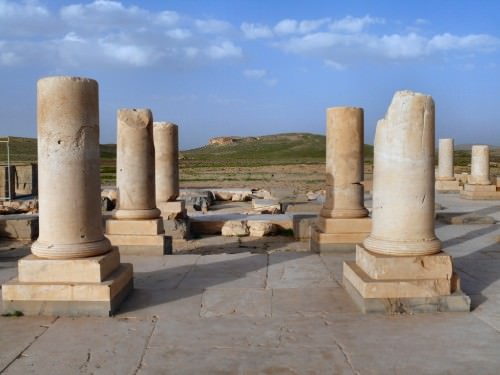
Pasargadae Palace
The monuments of Pasargadae contain influences from across the known world, including Assyrian style sculptures and Ionian style masonry. The Tomb of Cyrus is thought to represent a Mesopotamian or Elamite ziggurat with an Urartaean style cella on top. Pasargadae flourished only for a short time, with Persepolis taking over its role as the ceremonial capital in 515 BCE.
CONQUEST OF LYDIA
Cyrus conquered Lydia sometime between the fall of Ecbatana (550 BCE) and the fall of Babylon (539 BCE). The Nabonidus Chronicle states that Cyrus led a campaign west of the Tigris in 547 BCE, however, most scholars now agree that this campaign had a different target. Herodotus claims that it was Croesus (560-547 BCE), king of Lydia, who started the war by crossing the Halys River and sacking Pteria, a Cappadocian city within the Median sphere of influence. Croesus was an ally and brother-in-law to Astyages, so upon hearing that Cyrus had deposed Astyages, he swore to avenge him. The two armies met near Pteria, but the battle ended in a stalemate. When Croesus decided to march his army home for the winter season, Cyrus pursued him into Lydia and confronted him a second time near Thymbra. Cyrus deployed dromedaries to disperse the Lydian cavalry forcing Croesus to retreat into his capital city of Sardis, which fell after a 14-day siege.

Empire of Cyrus the Great
There is some discussion as to what happened to Croesus after his final defeat. Herodotus, Ctesias, and Xenophon all agree that Cyrus threatened to punish Croesus first, but that he took pity on him and even appointed him as his personal advisor. So far, it seems plausible that Croesus survived the fall of Sardis. Some scholars, however, consider such accounts to be legendary and believe that Cyrus did indeed execute Croesus. After the fall of Sardis, Cyrus put a Lydian named Pactyes in charge of Croesus' treasury. Pactyes' job was to send these treasures to Persia, but, instead, he organised a revolt, hiring mercenaries. Cyrus' sent his general Mazares to quell the rebellion, but due to his untimely death, it was Harpagus who completed the conquest of Asia Minor, capturing the cities of Lycia, Cilicia, and Phoenicia by building earthworks.
OTHER CAMPAIGNS
Sometime in the 540s BCE, Cyrus must have conquered the Bactrians and the Sacae. According to Ctesias, when the Bactrians heard that Cyrus had treated Astyages with respect, they voluntarily submitted to them, implying that the Bactrians had been either subjects or allies to Astyages. After strengthening his influence over the eastern part of the Iranian Plateau, Cyrus turned his attention to the nomadic Sacae. He captured their king Amorges, but Amorges' wife Sparethra gathered an army of 300,000 men and 200,000 women and defeated Cyrus in battle. Cyrus released Amorges and the two kings became allies, attacking Lydia together. If this account is true, Cyrus may have conquered the Bactrians and the Sacae before conquering Lydia. Finally, Cyrus must have conquered the region of Armenia in the mid-6th century BCE, possibly installing his ally Tigranes Orontid as king of Armenia.
CONQUEST OF BABYLON
In 539 BCE Cyrus invaded the Babylonian Empire, following the banks of the Gyndes (Diyala) on his way to Babylon. He allegedly dug canals to divert the river's stream, making it easier to cross. Cyrus met and routed the Babylonian army in battle near Opis, where the Diyala flows into the Tigris. After this, the people of Sippar opened their gates to him without resistance.The Babylonian king Nabonidus fled, and Cyrus sent his servant Ugbaru, the governor of Gutium, to capture Babylon. Ugbaru captured the outer neighbourhoods of Babylon, with only the temple district of Esagil remaining under Babylonian control.After two weeks, Cyrus was welcomed into Babylon with festivities.
With Babylon under Persian control, Cyrus could add the title 'king of Babylon' to his name. He inherited all the territories that had belonged to the Babylonian Empire, and he apparently had no trouble pacifying these regions. In fact, Harpagus may already have conquered much of the Mediterranean coast before Cyrus attacked Babylon. Cyrus now ruled over the fertile river valleys of Mesopotamia, in addition to the rich Mediterranean coast.
CYRUS CYLINDER
Not long after the conquest of Babylon, Cyrus commissioned a building inscription to be written in his name. This building inscription, better known as the Cyrus Cylinder, served to explain and justify Cyrus' conquest of Babylon to a Babylonian audience. The document appeals heavily to the Babylonian ideals of kingship. Nabonidus is described as an incompetent, godless king, while Cyrus is described as a divinely appointed saviour.
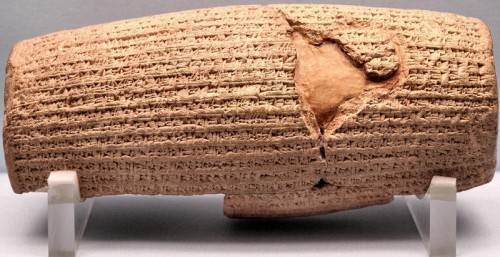
Cyrus Cylinder
The Cyrus Cylinder starts off by claiming that Nabonidus neglected the cult of Marduk, the patron god of Babylon. Nabonidus did indeed prefer the moon god Sîn over the national god Marduk, so there may be some truth to this. Still, it is likely that the neglect of the cult of Marduk was strongly exaggerated. Nabonidus also imposed heavy labour on his people, perhaps in preparation for the Persian invasion. Marduk, feeling pity for the people of Babylon, searches all the lands for a truly righteous king, eventually choosing Cyrus of Anshan. Marduk leads Cyrus to victory against the Medes and helps him capture Babylon without a battle.
Cyrus then introduces himself first as a king of Babylon, a king of Anshan, a descendant of Teispes, and a favourite of Marduk.Cyrus claims that he has not pillaged the city, that he has not frightened anyone, that he had worshipped Marduk daily, and that he had freed the people of Babylon from the heavy labour that Nabonidus had imposed on them. Cyrus also claims to have returned the idols, that Nabonidus had brought to Babylon from temples all across Mesopotamia, back to their temples, along with their temple personnel. Cyrus finishes his speech with a prayer to Marduk and a description of his building activities.
RELIGION OF CYRUS
Although it is often assumed that Cyrus was a Zoroastrian, there are no contemporary sources that describe him as a follower of Zarathustra of even a worshipper of Ahura Mazda. In fact, Zoroastrianism, as we know it today, may not even have existed during his lifetime. The beliefs and practices associated with Zoroastrianism were not standardized until the late Sasanian period. Before that time there was no orthodoxy and the Iranians adhered to a wide array of loosely associated beliefs and practices. Ahura Mazda was just one among many Iranian gods and Zarathustra was just one prophet who happened to favour Ahura Mazda over all the others. Taking this into account, it is likely that Cyrus was a polytheist who grew up worshipping the traditional Iranian gods. Xenophon describes him as swearing an oath to Mithra, the Iranian god of oaths, but he may have turned to other gods for other purposes. It should therefore not surprise us that Cyrus offers sacrifice to the Babylonian gods Marduk and Nabu. This was his way of placating the gods of the lands that he conquered.
DEATH
As with his birth and youth, not much is known about the last nine years of Cyrus' life. Herodotus claims that Cyrus died fighting the Massagetae, a nomadic people who lived across the Iaxartes. Queen Tomyris of the Massagetae allegedly beheaded Cyrus in order to avenge the death of her son at his hands. Ctesias claims instead that Cyrus died trying to put down a revolt of the Derbices, another nomadic people from Central Asia, while Berossus claims that Cyrus died fighting the Dahae nomads. It is likely that Cyrus did indeed die in Central Asia while trying to expand his influence over the region. From Babylonian letters, it is known that Cyrus died before December 530 BCE. He was buried in his tomb in Pasargadae, along with his cloak, his weapons and his jewels. Upon his death, Cyrus was succeeded by his son Cambyses II.

Tomb of Cyrus
LEGACY
Between the beginning of his revolt against Astyages in 553 BCE and his death in 530 BCE, Cyrus united all the lands between the Aegean Sea and the Iaxartes under his rule. By means of several swift campaigns, he dethroned many powerful kings, either appointing Persian satraps in their stead or claiming the title of 'king' for himself. This way he established Persian dominance over the entire Middle East. Upon conquering a kingdom, Cyrus usually allowed the local officials to maintain their position. This way, the administrative infrastructure remained intact. He also accommodated the cultural and religious practice of the lands that he conquered, thus winning the respect of his subjects and securing the loyalty of the traditional elites in the kingdoms he conquered, such as the Median nobility and the Babylonian priesthood.
In order to truly understand the significance of Cyrus' policy towards subject population, it should be kept in mind that the Achaemenid Empire at that time was little more than a personal collection of kingdoms that Cyrus had conquered. This empire was held together mostly through personal loyalty to the king. Over time, the “imperial structure” of the Achaemenid Empire became more standardized, especially after the reforms of Darius, but it was Cyrus who, through his conquests and his ability to inspire loyalty among his subjects, laid the foundations of the Achaemenid Empire.
Artaxiad Dynasty › Origins
Definition and Origins
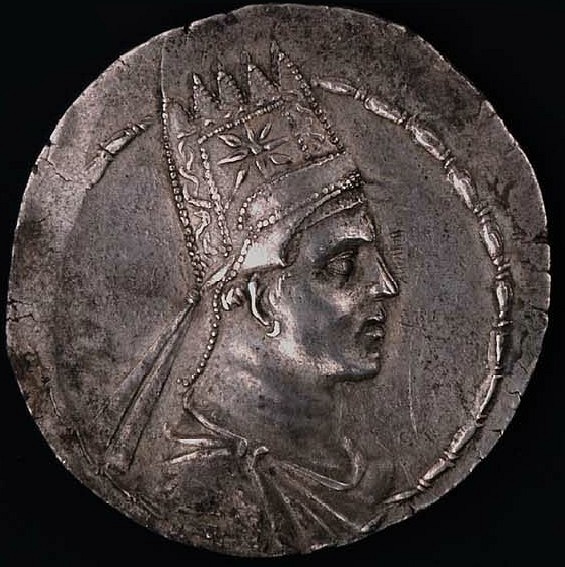
The Artaxiad (Artashesian) dynasty ruled ancient Armenia from c. 200 BCE to the first decade of the 1st century CE. Founded by Artaxias I, the dynasty would ensure Armenia enjoyed a sustained period of prosperity and regional importance. One of several important Artaxiad rulers was Tigranes the Great, who greatly expanded his kingdom before its ultimate defeat to the Romans in the mid-1st century BCE. Thereafter, the kingdom would become a pawn in the wider politics and wars involving Rome and Parthia.
DECLINE OF THE ORONTID DYNASTY
The Orontid dynasty had ruled ancient Armenia as Persian satraps from the 6th century BCE, then they had governed under the suzerainty of the Macedonians and the Seleucid Empire following the region's conquest by Alexander the Great in the latter half of the 4th century BCE. The last of the Orontid dynasty to rule in eastern Armenia was king Orontes IV (to the Armenians, Yervand IV or Yervand the Last, rc 212-200 BCE). Yervand, who, like many of his predecessors, had given himself the title of king, moved the capital from Armavir to the newly founded Yervandashat, meaning “Yervand's Joy”. Around 200 BCE Yervand IV was murdered and Artaxias I (aka Artashes or Artaxerxes), backed by the Seleucid ruler Antiochus III (r. 222-187 BCE), was made the empire ’s satrap in Armenia. Contrary to the traditional view initiated by ancient authors, it seems likely that the Orontid and Artaxiad rulers did share a common ancestry as revealed by name conventions and recently discovered inscriptions on Armenian boundary stones.
ARTAXIAS HAS BECOME ONE OF THE MOST REVERED OF ALL ARMENIAN KINGS & THE SUBJECT OF POEMS & SONGS EVER SINCE HIS REIGN.
ARTAXIAS I
Antiochus probably thought a change of regime would reduce the increasing trend of Armenian independence from Seleucid overrule. To this end, he created two satraps: Artaxias in Armenia and Zariadris in Sophene to the southwest. However, when Antiochus was defeated by the Romans at the Battle of Magnesia in 190 BCE, Artaxias declared himself king and set about expanding his kingdom, first by marriage to Queen Satenik of Asian Iberia. Artaxias conquered part of Media Atropatene north of the Arax River while in the south, the areas of Phaunitis and Armenian Siunik, and in the west, Vaspurakan, were annexed.The kingdom was unified as never before with an administrative centralisation and such innovations as boundary stelae to proclaim property rights and the authority of the crown. No wonder, then, that Artaxias has become one of the most revered of all Armenian kings and the subject of poems and songs ever since his reign.
A new capital was founded on a peninsula of nine hills at Artaxata (Artashat) in 176 BCE. Hannibal, the great Carthaginian general, was said to have designed the city ’s fortifications when he served Artaxias following his defeat to the Romans.These and other features of the city are described by the historian RG Hovannisian:
The city contained a citadel on the height later called Xor Virap (Khor Virap) and was protected by extensive fortifications and a moat. Recent excavations have a revealed a major urban center with paved streets, public buildings, baths, shops, and workshops of various craftsmen…it rapidly became a major junction point between the trade route along the valley of the Araxes leading outward to Bactria and India and the one running northward to the Black Sea. (49)
Artaxias' long reign finally came to an end sometime between 165 and 160 BCE but his line continued with his two sons, first with the brief reign of Artavasdes (Artawazd) and then Tigranes I (Tigran I), whose succession date is unknown and who would rule until 95 BCE. Not much is known about either ruler beyond a few excavated coins corroborating their existence which previously had been suggested only by the appearance of their names in a few ancient texts.
TIGRANES II THE GREAT
After a rather dim period in the historical record for Armenia, a shining light suddenly arrives on the scene with a mass of documentation covering the greatest of Artaxiad kings, or indeed any Armenian king, Tigranes II (Tigran II) or Tigranes the Great (r. c 95 - c. 56 BCE). He was put upon the throne of Armenia by the Parthians after his uncle, the Armenian king Artavasdes I, had been forced to send Tigranes as a hostage to them. When his father Tigranes I died c. 95 BCE, Tigranes was sent back to Armenia to take his place on the throne. The new king had to cede the “Seventy Valleys” to the Parthians (a territory probably towards modern Azerbaijan) although he soon proved to be anything but a compliant client ruler.
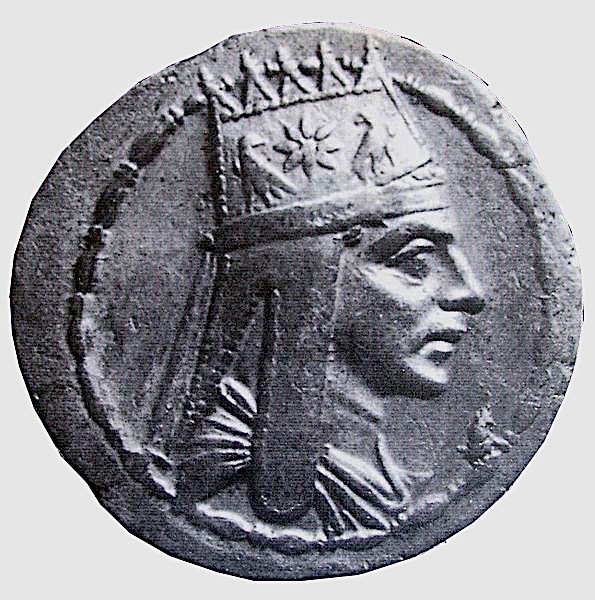
Tigranes the Great
Tigranes took advantage of the Parthians being distracted by invasions on their eastern borders and set about expanding his own kingdom even further. First, he annexed the other part of traditional Armenia, the kingdom of Sophene, in 94 BCE. With formidable siege engines and units of heavily-armoured cavalry, he then re-took the “Seventy Valleys” and conquered Cappadocia, Adiabene, Gordyene, Phoenicia and parts of Syria, including Antioch. The Armenian king even sacked Ecbatana, the Parthian royal summer residence, in 87 BCE while the Parthians were struggling to deal with invading northern nomads. At its peak, Tigranes the Great's Armenian Empire stretched from the Black Sea to the Mediterranean. Not before or since would Armenians control such a huge swathe of Asia.
IT SEEMED THAT WHICHEVER SIDE ARMENIA CHOSE - ROME OR PARTHIA - THE SMALL KINGDOM CAUGHT BETWEEN THESE GREAT EMPIRES WOULD ALWAYS COME OFF SECOND BEST.
From 85 BCE Tigranes rather grandly began calling himself the “King of Kings”, although the title is further evidence that he left conquered monarchs to rule as vassals. The conquered states were obliged to pay tribute and populations were relocated to reduce dissension and increase loyalty wherever required. Tigranes was noted as an admirer of Greek culture and the capital city he founded in 83 BCE, Tigranocerta (aka Tigranakert, and of uncertain location), was famously Hellenistic in its architecture. The Greek language was likely used, along with Persian and Aramaic, as the language of the nobility and administration while commoners spoke Armenian. Persian elements continued to be an important part of the Armenian cultural mix, too, especially in the area of religion
Tigranes then made his major political blunder and allied himself with Mithridates VI, the king of Pontus (r. 120-63 BCE) and great enemy of Rome. Admittedly, Tigranes was married to Mithdradates' daughter Cleopatra and, really, it seemed that whichever side Armenia chose - Rome or Parthia - the small kingdom caught between these great empires would always come off second best.
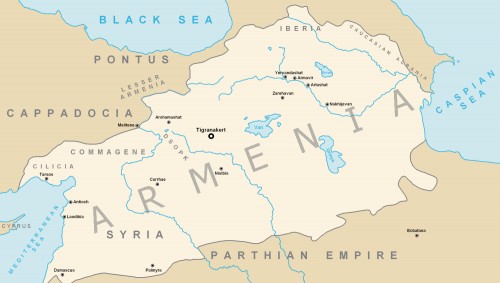
Tigranes the Great's Armenian Empire
The Roman Republic, seeing the danger of such an alliance between the two regional powers, responded by attacking Pontus and when Mithridates fled to the court of Tigranes in 70 BCE, the Romans invaded Armenia. Tigranes was defeated by a Roman army commanded by the general Licinius Lucullus, Tigranocerta was captured in 69 BCE and the Armenian king was forced to abandon his conquests. Following another Roman attack c. 66 BCE, this time led by Pompey the Great, Armenia was made into a Roman protectorate. Thereafter, the state became a bone of contention between Rome and Parthia (and its successor, Sasanid Persia ) but Tigranes continued to rule most of Armenia as a vassal state of the Roman Empirewhich acted as a useful buffer to the Parthians until his death c. 56 BCE aged 85.
ROME, PARTHIA & DECLINE
Artavasdes II (rc 56 - c. 34 BCE), son of Tigranes II, was known as a philosopher king because of his literary works in Greek, none of which, unfortunately, survive. Armenia continued its precarious position between the Roman Empire in the west and Persia in the east. The Roman general Marcus Licinius Crassus obliged Artavasdes to support his campaign against the Parthians in 53 BCE but following its spectacular failure, when the richest ever Roman lost both his army and his head, an alliance was re-formed between Armenia and Parthia and cemented by Artavasdes betrothing his sister to the eldest son of the Parthian king Orodes II (r. 57-37 BCE).

Marcus Licinius Crassus
However, in 36 BCE, the region was again destabilised when another Roman general, this time Mark Antony, passed through, and the Armenians were, once more, asked to provide troops. Once again, the Romans were defeated by their nemesis the Parthians. In 34 BCE Antony then moved against the Artaxiads, taking Artavasdes to Alexandria where the flamboyant triumvir controversially celebrated an unofficial triumph for his victories in Armenia. Artavasdes would later be executed by Queen Cleopatra.
Meanwhile, the Parthians installed Arteses (Artashes) II as king of Armenia in c. 30 BCE, one of the sons of Artavasdes. Then, in 20 BCE, Rome reasserted its claim over the region when Emperor Augustus sent Tiberius to reinstall a king of Armenia who was more loyal to imperial Rome: Tigranes III. In a game of musical thrones, the Parthians installed Tigranes IV in 8 BCE, who was then briefly replaced by the Roman-backed Artavasdes III in 5 BCE, before regaining his seat in 2 BCE, although this time he had to share it with his sister Erato. Three more changes would occur over the next decade but the music was about to stop for good.
The volatile political reality of the region in this period is reflected in the short reigns and frequent change of subsequent monarchs: nine rulers up to the first decade of the 1st century CE. The decline of the Artaxiads was also in part due to the internal factions which had been created by the nobility splitting into either pro-Roman or pro-Parthian factions. In unclear circumstances, the Artaxiads were succeeded by the next dynasty to dominate Armenian affairs, the Arsacid (Arshakuni) dynasty, when their founder, Vonon (Vonones) took the throne in 12 CE.
This article was made possible with generous support from the National Association for Armenian Studies and Researchand the Knights of Vartan Fund for Armenian Studies.
Colchis & Iberia in Antiquity › Origins
Ancient Civilizations
Colchis (western Georgia) and Kartli/Iberia (eastern and southern Georgia) were important regions in the Caucasus area of Eurasia from the Bronze Age of the 15th century BCE. Prospering through agriculture and trade, the region attracted Greekand then Roman colonists. The success of several cities is indicated by the minting of their own coinage. The languages, religion and arts of the region reflect the cosmopolitan political reality through the Hellenistic and Roman periods.

Colchian Silver Tetradrachm
GEOGRAPHY
Georgia extends southwards from the Caucasian range and eastwards from the Black Sea, which has served as a highway to the rest of the world since antiquity. Georgia contains all the principal landforms like plains, hills, plateaus and mountains.Climate varies across the country. Much of the Black Sea coast has a humid subtropical climate with warm winters and plentiful rainfalls. Having a semiarid climate, East and South Georgia receive little rainfall and so farmers have to rely on irrigation. The mountains possess a highland climate. People make their living by herding and cutting timber. Some rivers are navigable, while fast-flowing streams provide effective power. Georgia had rich deposits of iron, copper and other minerals although now they are mostly emptied. Deposits of oil seem not to be prominent.
NAMES & LANGUAGES
The West was Colchis; and the East and the South Kartli, the Greeks called it Iberia. The native name "Kartli" is of Indo-European provenance and means "citadel". When a lord of this "citadel" near the Georgian city of Mtskheta became a ruler of the whole country, this term spread over the entire territory. And for the Greeks living in the neighbouring Trebizond, the closest Kartlian province was that of Speri (now Ispir in Turkey ). The Greeks used various names for these peoples, calling the Kartlians "Sasperians", then "Hesperians", and then "Iberians". The term "Colchis" seems to be derived from the name of the mountainous province of Kola (now in Turkey) while Georgia (Sakartvelo) is an economic synthesis of the West and the East. The native name has been derived from Kartli.
POWERFUL CLANS SET UP SMALL STATES LIKE DIAOKHI, ZABAKHA, VITERUKHI & COLCHA AS FAR BACK AS THE 12TH CENTURY BCE.
Georgians speak the languages of the Ibero-Caucasian family which are as follows: Georgian properly, Mingrelian and Svanetian. Ancient Georgia was formed by an economic synthesis of the East (Iberia) and the West (Colchis), and since then the Mingrelian (ie Colchian) language has been transferred to a position of a family language. A bit earlier the Svanetian and the Abkhasian languages were put on the same position by the Mingrelian language.
AGRICULTURE
Rich soil, rivers like the Rioni, Chorokhi and Mtkvari (Kura) filled with fish, and besides a ready source for irrigation, helped the early settlers to raise grains. The most successful farming settlements had grown into powerful clans. Crafts and trade flourished across wide areas. In the early centuries of the 2nd millennium BCE two principal economic systems were created.Later they will be called Colchis and Kartli. The Georgian clans are best known in history for their mastery of bronze and iron.The Bronze Age civilizations, which endured and developed over two millennia, gave place to Iron Age communities c. 1000 BCE.

Map of Ancient Georgian States (600-150 BCE)
The prosperity of the Georgian clans was linked with the possession of the rich valleys of the rivers Mtkvari (Kura), Chorokhi (Aphsaros/Acampsis) and Rioni (Phasis). Agriculture was important and could find a market for its produce in the small towns scattered around. Wherever irrigation had to be maintained (Kura-river valley), channels were built.
CONTACT WITH GREECE
A well-planned system of defence – small states like Diaokhi (Tao) and Colcha etc. being allied – lessened the risk of enemy raids. Corn-fields were cultivated, flocks of sheep and herds of cattle roamed in the upland – on the slopes of the North and South Caucasian Mountains, which provided some more safety to the area. Still, the Greeks managed to arrange naval expeditions against the East Black Sea Coast, and those were augmented by the myth which told of how a brave Helleniccrew – the Argonauts – headed by Jason, stole the Golden Fleece, an obvious symbol of luxury and abundance, from Colcha/Colchis. Another violator in mythology was Prometheus, who seized fire from the gods and gave it to humanity. He was then punished and chained to a rock in the Caucasus. The Georgian version of the myth names Amiran as the hero who is reminiscent of Mithra, the Arian pagan deity or devi – indeed, the Arian clans came to the region at the dawn of the civilization and then mingled with the natives.
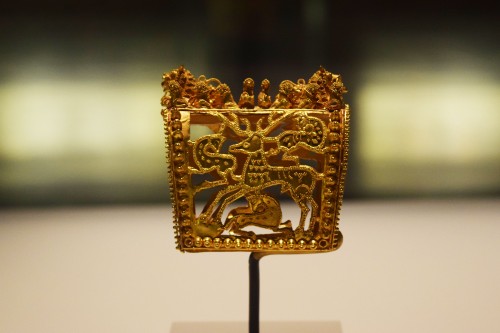
Portion of an Colchian Headdress
EARLY STATES
The powerful clans set up small states like Diaokhi, Zabakha, Viterukhi, Colcha etc. as far back as the 12th century BCE.Kings ruled and made the law, while wealthy landowners held public offices, and fought Assyrians and Urartians, moving northwards. At the bottom of the society were the common people. They worked on lands belonging to the aristocracy but were still free to leave this land, and yeomanry dwelt in the high-up mountains. Increased trade led to the growth of the towns.The merchants gained some wealth and began to form a middle class. Women were subordinated to men.
Two cultures, armed with iron, are established finally – East Georgian (Iberian), in the valleys of the rivers Mtkvari and Chorokhi; and West Georgian, Colchian (ie Mingrelian), in the valley of Rioni, in the plains between the cities of Pitius (Bichvinta/Pitsunda) in the Northwest, Aphsaros (Gonio) in the Southwest and Sarapanis (Shorapani) in the East. Tough mountain folks like the Svani and Lazi (West Georgians) lived in the wild regions above the cities of Dioscurias (Sokhumi) and Trapezus.
GREEK COLONIES
By the 6th century BCE, the Persians had conquered a vast empire that stretched from Asia Minor to the Indus valley.Some of the Iberian lands were under Persian rule but still, the world was now facing a new hegemonic power – Hellas, already overpopulated and needing grain and raw materials to be imported. The Greeks set up small city-states ( poleis ) along the Black Sea coast. They earned a living through commerce, supplying the parent country with raw materials. Milesians from Asia Minor also established several colonies in Colchis, comprising West Georgia.
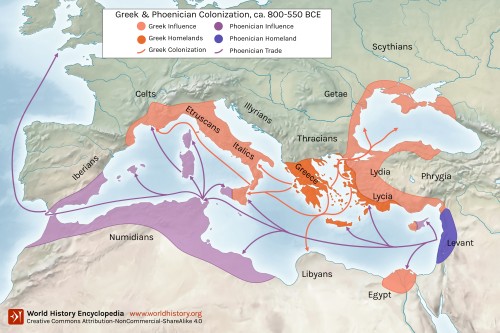
Greek and Phoenician Colonization
In the 7th-6th century BCE the Ionian city of Miletus possessed exceptional wealth and commercial enterprise. Miletus, the greatest trading city, organized the first Greek settlements in Colchis, daughters of the Ionian metropolis – Phasis (Poti), Dioscurias (Sokhumi) etc. Phasis and Dioscurias were splendid Greek cities dominated by mercantile oligarchies, although they were sometimes troubled by the Colchians from the hinterland. These Greek cities seem to have been completely assimilated by the Colchians.
SPICES, PRECIOUS WOODS & STONES CAME FROM INDIA VIA THE CHEAP “TRANSCAUCASIAN” RIVER-ROUTE.
In subsequent centuries the same process happened with the settlement of Roman veterans near Phasis. To promote trade, Phasis issued its own silver money with the Graeco-Colchian type of coins. Trade of the peoples across the Black Sea thrived.The armament industry and ceramic production flourished in Pontus, mining was productive in Colchis, and agriculture in the Bosphorus area. Almost everywhere town increased in size and prosperity. Large and frequent issues of coins became necessary and their circulation increased. The age-old maritime route from Sinope towards Phasis was easily covered in three days. From the 3rd century BCE the Greeks flooded into and through Colchis and Iberia. Spices, precious woods and stones came from India via the cheap “Transcaucasian” river-route along the rivers of Indus – Balkh (Bactra) – Amu-Daria ( Oxus ), joining in the past, the Caspian Sea in the Southeast section, Mtkvari and Rioni.
ALEXANDER THE GREAT
Alexander of Macedon defeated the powerful Persian Empire in the 4th century BCE. His conquest paved the way for the penetration of the Greek civilization in many areas. The whole Black Sea area might be looked upon as a multicultural region of which the economic systems were ultimately based on the principle of Hellenism – Greeks settled everywhere. An idea of Hellenistic integration is reflected in the Colchian imitation of the gold coins of Alexander. More and more Greeks arrived in Colchis. Colchis was well packed with naval resources and the best sailors but in many lowland places there were terrible marshes, and the Greeks had no special idea about draining those marshlands. Ultimately, Hellenism in Colchis failed because the Hellenic communities first became bilingual and then completely assimilated into the local societies.

Colchis Alexander Stater
After the destruction of the Persian Empire, the Northern and Southern kingdoms of Kartli were united under Pharnavaz from Mtskheta (Northern kingdom), the first king of the Pharnavazid dynasty. Azo, the Southern sovereign, seems to have been killed in a skirmish. Pharnavaz gratefully adopted his sons and kept them within the native domains as dukes ( eristavi ). After many centuries those domains will provide Georgia with a new royal dynasty, the Bagratids (Bagrationi).
THE ROMAN EMPIRE
Starting from the 1st century BCE the Romans administered the old Hellenistic World. They promoted European unity by offering citizenship to their allied kings. Iberian rulers were among them. Roman citizenship was a traditional honorary degree passed from the European principal domains towards the provinces, the countries being tied up formally. A silver cup of the 2nd-3rd century CE records a name of the Iberian (Kartlian) king Flavius Dades (reign dates unknown). Evidently a Roman citizen, he inherited his citizenship from a predecessor upon whom either Vespasian or Domitian had conferred it. In another example, the citizenship of Publicius Agrippa, an Iberian commander-in-chief, derived from a grant of C. Publicius Marcellus, Hadrian ’s governor of Syria. Sometimes the high jobs in the Roman army went also to Iberians. For example, the appointment of a capable admiral is recorded in the times of Emperor Otho. His name was Moschus, and obviously, he was born in the Iberian province of Meskheti.
While sending the men to serve outside the land, Iberia welcomed some foreigners - already in the 2nd century BCE the capital Mtskheta had its mercantile Jewish quarter. And the Colchians faced Roman garrisons stationed along the Black Sea coast. Goths, dwelling in the Crimea and looking for new homes, raided Colchis in 253 CE. Still, the country was not against any reception, whenever demanded. Colchians were always watchful of the mountaineers North of the Caucasian Range but in the 1st century CE they did not reject the opportunity to gain more recruits for the feudal class. Thus Abasks and Aphsils appeared in Colchis, together with a sizeable Lazi population from South, who renamed the land Lazica. During this slight Roman hegemony the waves of Lazi clans from Trapezus, speaking the same Mingrelian language, swept Colchis to create a new feudal structure. Soon Iberia exercised the same system.
CULTURE
Artistically and intellectually the period is outstanding as a starting point. Greek style temples were built both in Colchis and Kartli (Iberia). In Ancient Colchis and Kartli folk believed that many gods controlled the forces of nature. Idols were worshipped but the latter's paganism is still imbued with a certain romanticism due to Aryan superstrata coming to Iberia at the dawn of civilization, bringing their pagan deities (devi – in Georgian) like Mithra-gayo-da (the life-giving one; Gaim – in Georgian) and Aredvi Sura Anahita (Ainina in Georgian). The next reception included already those who worshipped the Lord Wisdom, a pure idea – Ahuro Mazdao, which was paganized in Georgia and converted into the warrior-Armazi. So, this Armazi, together with Gaim and Ainina were worshipped in Kartli, before this country had been baptized. Colchian jewellery is also very multicultural and the Georgians used to write in Greek and Aramaic. Georgian records are accurate describing the crowded pagan festival in Mtskheta, with the king himself as a participant. Armazi was widely worshipped, while archaeology reveals plenty of skulls in burials with a coin set inside – a dead man is thought to be transferred to another world by the mystic paid boatman, Charon, and the normal place where people carried money was in the mouth.
LICENSE
Article based on information obtained from these sources:with permission from the Website Ancient History Encyclopedia
Content is available under License Creative Commons: Attribution-NonCommercial-ShareAlike 3.0 Unported. CC-BY-NC-SA License